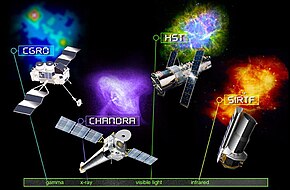
Back برنامج المراصد الكبرى Arabic Grandes Observatorios AST Böyük Rəsədxanalar proqramı Azerbaijani Programa dels Grans Observatoris Catalan Velké observatoře Czech Great Observatories program Danish Grandes Observatorios Spanish Behatoki Handiak programa Basque Programme des Grands Observatoires French Grandes Observatorios Astronómicos Galician

NASA's series of Great Observatories satellites are four large, powerful space-based astronomical telescopes launched between 1990 and 2003. They were built with different technology to examine specific wavelength/energy regions of the electromagnetic spectrum: gamma rays, X-rays, visible and ultraviolet light, and infrared light.
The Hubble Space Telescope (HST) primarily observes visible light and near-ultraviolet. It was launched in 1990 aboard the Space Shuttle Discovery during STS-31, but its main mirror had been ground incorrectly, resulting in spherical aberration that compromised the telescope's capabilities. The optics were corrected to their intended quality by the STS-61 servicing mission in 1993. In 1997, the STS-82 servicing mission added capability in the near-infrared range, and in 2009 the STS-125 servicing mission refurbished the telescope and extended its projected service life. It remains in active operation as of October 2024[update].
The Compton Gamma Ray Observatory (CGRO) primarily observed gamma rays, though it extended into hard x-rays as well. It was launched in 1991 aboard Atlantis during STS-37. It was de-orbited in 2000 after a gyroscope failed.
The Chandra X-ray Observatory (CXO) primarily observes soft X-rays. It was launched in 1999 aboard Columbia during STS-93 into an elliptical high-Earth orbit, and was initially named the Advanced X-ray Astronomical Facility (AXAF). It remains in active operation as of October 2024[update].
The Spitzer Space Telescope (SST) observed the infrared spectrum. It was launched in 2003 aboard a Delta II rocket into an Earth-trailing solar orbit. Depletion of its liquid helium coolant in 2009 reduced its functionality, leaving it with only two short-wavelength imaging modules. It was removed from service and placed into safe-mode on January 30, 2020.